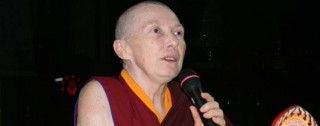Submitted by zhenliang on

Venerable Karma Lekshe Tsomo teaches Buddhism and World Religions at the University of San Diego. She is an ordained American bhikshuni of German descent. She is the president of Sakyadhita: International Association of Buddhist Women and has helped organized nine national and international Sakyadhita conferences since 1987. She is one of the founders of eight education programmes for women in the Indian Himalayas. She has written a number of books, amongst them is “Living and Dying in Buddhist Cultures” with David W. Chappell.
On Tuesday, 3 January 2006, evening, Venerable Tsomo gave a dharma talk at Dai Bei Dian (Hall of Great Compassion) on Death and Dying in Buddhist Cultures. In her talk, Venerable Tsomo said that death is definite while the time of death is indefinite. What should be borne in mind was that all the money, awards, friends and even family members
would be of no use at the moment of death. In fact, family members could be a hindrance due to the attachment involved. What would stand anyone in good stead at the moment of death is the spiritual or Dharma practice.
Dharma practice, Venerable Tsomo said, includes meditation such as breathing meditation or being mindful of the breath, chanting sacred texts and mantras, and meditation on stages of dying process. She said that even in the stage of dying, one should maintain one's Dharma practice by doing meditation. Of course, the physical pain, weakness and discomfort would be distracting and affect concentration. The drugs given would also induce disorientation and lack of mindfulness.
Venerable Tsomo told of the time in India when a deadly viper fell from a tree and bit her on her right arm. The doctors could not amputate her arm to save her life as she was near death and also they did not know who would foot her medical bills, so she was left to die. She miraculously survived and had reconstructive surgeries on her right arm. She mentioned that all the time when she was near death, she was well aware of what went on around her and she could hear what the doctors were saying about her, some of which were quite unpleasant.
Venerable Tsomo said death gives insight to impermanence and suffering, and provides the opportunity for the practice of patience, compassion and momentary awareness. Death also offers the opportunity for achieving liberation or enlightenment.
She then went on to touch on issues concerning medical ethics that involves abortion, suicide, euthanasia or assisted suicide, organ donation and stem cell research. In light of Buddhist thinking, it is wrong to carry out abortion, commit suicide and euthanasia as such acts involved taking a human life. Organ donation is considered a good act as it is the highest form of dana (practice of generosity). Venerable Tsomo cautioned that in Tibetan Buddhism, it is believed that the consciousness is still around for a few days even though the heart has stopped beating and breathe is absent. It can thus be disconcerting to the departed to “see” the organs being freshly harvested, unless the level of compassion is high enough not to be disturbed by it.
With regards to stem cell research, it was a debatable issue as embryos are considered a life form. There is a short period, however, before consciousness enters the embryo that the embryo is considered devoid of life. If the embryo was harvested at that early stage, then it would not be considered wrong ethically as no life was taken. However, the time when the embryo started life and the time when it was harvested could not be determined with any degree of certainty; hence stem cell research is still in a grey area where Buddhist ethics is concerned.
In the question and answer session, a member of the audience brought up the issue of aborting a foetus that was scanned and found to be physically deformed. Wouldn't it be expedient to abort such a foetus rather than allow it to be born and incur hardships at great expense to the parents, he asked. Venerable Tsomo answered that if nature is allowed to take its course; such a defective foetus would be naturally aborted. It was only with the intervention of medical science (in this case, the scanning that showed the foetus to be deformed) that such issues of ethics arose. Similarly, putting a comatose patient in a life-support system gave rise to the issue of when to turn off the life-support.
The evening ended with food for thought for everyone present. It was interesting to learn of the Tibetan Buddhist concept of death and its various stages. The many issues raised also provided a lot of room for reflection on the many realities of death and, while most medical issues were straightforward where Buddhist ethics is concerned, the one on stem cell research is still controversial.

